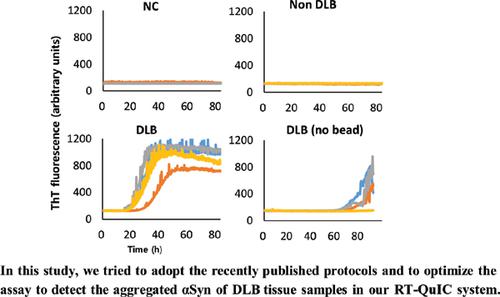Protein & Peptide Letters ( IF 1.0 ) Pub Date : 2020-12-31 , DOI: 10.2174/0929866527666200420105352 Seok-Joo Park 1 , Yun-Jung Lee 1 , Jeong-Ho Park 1 , Hyoung-Tae Jin 1 , Myoung-Ju Choi 1 , Cha-Gyun Jung 2 , Hiroyasu Akatsu 3 , Eun-Kyoung Choi 1 , Yong-Sun Kim 1

|
Background: The accumulation of aggregated α-synuclein (αSyn) is known as one of the critical reasons to exhibit their variable molecular pathologies and phenotypes in synucleinopathies. Recent studies suggested that the real-time quaking-induced conversion (RT-QuIC) assay is one of the potential methods to detect these αSyn aggregates and could detect the aggregated αSyn in the brain tissue and cerebrospinal fluid (CSF) using the propensity of the prion-like oligomerization.
Objective: We tried to optimize the αSyn RT-QuIC assay based on the aggregation of αSyn in brain samples of synucleinopathies by comparing the conditions of the recently reported αSyn RTQuIC assays.
Methods: This study applied a highly sensitive RT-QuIC assay using recombinant αSyn (rαSyn) to detect aggregated αSyn in the brain tissue from dementia with Lewy bodies (DLB).
Results: This study compared αSyn RT-QuIC assays under conditions such as beads, rαSyn as a substrate, reaction buffers, and fluorescence detectors. We observed that the addition of beads and the use of 6x His-tagged rαSyn as a substrate help to obtain higher positive responses from αSyn RT-QuIC assay seeding with brain homogenate (BH) of DLB and phosphate buffer-based reaction showed higher positive responses than HEPES buffer-based reaction on both fluorescent microplate readers. We also observed that the DLB BHs gave positive responses within 15–25h, which is faster high positive responses than recently reported assays.
Conclusion: This established αSyn RT-QuIC assay will be able to apply to the early clinical diagnosis of αSyn aggregates-related diseases in various biofluids such as CSF.
中文翻译:

RT-QuIC法测定DLB患者聚集性α-突触核蛋白的方法的建立
背景:聚集的α-突触核蛋白(αSyn)的积累被认为是在突触核蛋白病中表现出可变的分子病理学和表型的关键原因之一。最近的研究表明,实时地震诱导转化(RT-QuIC)分析是检测这些αSyn聚集体的潜在方法之一,并且可以利用脑电波的倾向检测脑组织和脑脊液(CSF)中聚集的αSyn。病毒样低聚。
目的:通过比较最近报道的αSynRTQuIC检测条件,我们尝试基于突触核病脑样本中αSyn的聚集来优化αSynRT-QuIC检测。
方法:本研究应用高灵敏度的RT-QuIC测定法,使用重组αSyn(rαSyn)检测路易氏体(DLB)痴呆脑组织中聚集的αSyn。
结果:这项研究比较了在诸如珠子,rαSyn作为底物,反应缓冲液和荧光检测器等条件下的αSynRT-QuIC分析。我们观察到添加珠子和使用6x His标记的rαSyn作为底物有助于从αSynRT-QuIC分析接种的DLB脑匀浆(BH)获得较高的阳性反应,而基于磷酸盐缓冲液的反应显示出较高的阳性反应在两个荧光酶标仪上的基于HEPES缓冲液的反应。我们还观察到,DLB BHs在15-25h内给出了阳性反应,这比最近报道的测定更快的高阳性反应。
结论:建立的αSynRT-QuIC检测方法将可用于各种生物流体(如脑脊液)中αSyn聚集体相关疾病的早期临床诊断。











































 京公网安备 11010802027423号
京公网安备 11010802027423号